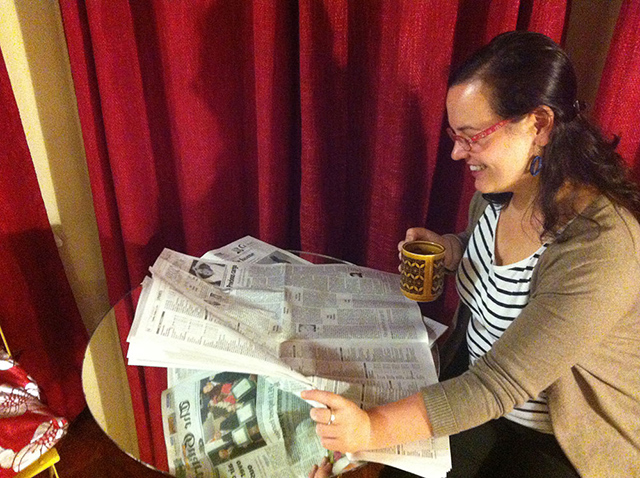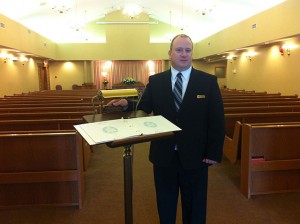Obits: celebrating life after death

caption
Lydia Hood, an Atlantic School of Theology student from Charlotteown, P.E.I, reads obituaries every day.Vibrant and vital, the obituary page is a memorable read
Most people have one. No one sees theirs. Often, they’re expensive. Sometimes they omit. They celebrate, communicate and conclude – and last long after you die.
Obituaries are one of the most widely read pages of the newspaper. They’re clipped out, stuck on fridges, pressed in Bibles, framed, laminated, and folded in the wallets of many a mourning survivor.
Ian Scott of the Halifax Chronicle Herald says, “Sometimes you can bugger up the editorial side of the operation. But don’t make a mistake on a puzzle or an obit, because the wrath of God will befall you.”
Death is a big deal.
Some fear death; others long for it. Some think death is the end; others believe it to be a beginning. Obituaries are read for a myriad of reasons: community connection, entertainment, historical research, and finding funerals. Obits are valued because they honour the deceased.
Commemorating and memorializing the dead is an ancient tradition. Short of building a pyramid, an obit is a lasting and meaningful way to document a human life.
Brief death announcements can be found in America as far back as the 16th century, and became more common in the 17th century. The word obituary, from the Latin obitus, meaning departure, came into use in the 18th century. At that time newspaper obituaries mainly documented deaths of prominent male figures, so obituaries perpetuated patriarchy. The Victorian era’s taboo on death introduced a poetic obit, filled with euphemism and flowery language. A 2006 study of Victorian obits says one wouldn’t just die, but “receive the unexpected summons of the tribunal of one’s judge,” or be granted the “joyful expectation of the resurrection of the just.”
The Death CodeEuphemisms in obituaries are cringeworthy to journalists today, but were alive and well in the 19th and 20th centuries. Here are a few expressions for kicking the bucket: • Counting the worms. • Went to paint the pearly gates. • Left to play accordion in Jesus’ band of angels. • Laid down the knife and fork. • Turned up his toes. • Has a little garden on his stomach. • Winked out. • Hung up the fiddle and the bow. Today families use simpler euphemisms, like “passed away peacefully.” |
This trend changed drastically in the latter part of the 19th century and early 20th century, which revelled in ornate and explicit descriptions of death. Theodore Roosevelt’s obits in the New York Times tells how a blood clot, the cause of his death, “detached itself from a vein and entered the lungs.”
Obits experienced a lull in popularity in the 20th century, following the First World War. Then, the obit was considered a mere clerical service by journalists, left to rookies and the nearly retired. In the 1980s acclaimed newspapers like the Daily Telegraph and the New York Times brought obits back as feature stories, in an effort to increase readability in an era of predominately televised news.
One type they rejuvenated was the “common man” obit. Journalists wrote these feature length obituaries on teachers, taxi drivers, tradesmen – and published them in reputable metropolitan newspapers. Jim Nicholson, a retired lieutenant-colonel of military intelligence with the U.S. army reserves, and an obit writer asks, if the premier “went on vacation for four weeks and your trash man went on vacation for four weeks, who would you miss more?”
Nicholson wrote around 4,000 feature length (20 to 30 inch) common man obits and about 20,000 briefs for the Philadelphia Daily News between 1982 and 2001. For the core of his retirement, Nicholson says, “I watch TV, smoke Camels and drink black coffee.” He also does a little oil painting.
An excerpt from his 1993 obit for one Christopher Kelly reads: “Society today does not assign extraordinary attributes to a 35-year-old heavy-equipment mechanic who is living with his parents and whose possessions do not appear to much exceed a Miller Light and a pack of Marlboros on the bar before him, a union card in his pocket and a friend on either side.”
Society may not have, but Kelly’s family did, and so did Nicholson.
“There’s no greater chance at immortality than having someone write your obituary.”
– Sandra Martin, Globe and Mail obit writer
There are few kinds of obituaries besides the common man feature. Genealogists and sociologists consider family-written tributes — the ones in the classified section of your local paper — obits when they tell a life story. A short clip of basic information is widely considered a death notice. In the Globe and Mail all family-written obits are death notices. The Herald, along with most smaller papers, doesn’t make a distinction between death notices and obits. They categorize obits by the department that handles them – the editorial section for feature length or the classified system for family-written.
Some obits are made in series, like the New York Times’ Portraits of Grief, a collection of obituaries written for the victims of Sept. 11. The Times also has a video series, Last Word, which is obits with interview clips, not published until after the person’s death.
Sandra Martin, an obit writer for almost 10 years for the Globe and Mail, and author of Working the Dead Beat, says advance obits always need revision because they sit collecting dust. She says people whose obits haven’t been written tend to die before the people whose obituaries are ready and waiting. “There’s no greater chance at immortality than having someone write your obituary,” says Martin.
Like most professional obit writers, Martin considers family-written tributes to be paid ads. They’re pleasant, but dangerously capable of canonizing the most controversial of characters.
Obituaries written for community newspapers don’t include people’s faults.
Martin says an obit should tell the truth, “warts and all.”
Andrew Meacham, president of the Society of Professional Obituary Writers, in Tampa Bay, Fla, says warts make people interesting. A drinking problem, five marriages, or a sense of humour intrigues readers. “It’s not some expose,” says Meacham. “You’re still summing up a life. But you’re trying to do it in a way that people can believe.”
Meacham has written around 1,000 feature length obituaries for the Tampa Bay Times. “Every life has a story worth telling,” he says.
It isn’t eerie on the death beat, says Meacham, but “there’s a certain loneliness to it.” It’s also daunting “taking a whole life and trying to decide, in the space of 14 column inches, what you’re going to say and what you’re going to leave out.”

caption
Richard Mulroy of Atlantic Funeral Homes in Dartmouth.Feature obits honour the deceased, but most people just get a family written obit. Richard Mulroy, of Atlantic Funeral Homes’ Dartmouth Chapel, helps families write obits. He types them with the family watching. “I truly think that’s part of the grieving process,” says Mulroy. “We’re human. We have to see to believe.”
Cost is always a factor with classified obits. “It gets expensive very quickly,” says Mulroy. Dartmouth Chapel’s average obit runs between $150 and $250, though the most expensive Mulroy has seen was $1,300 at the Herald. The same obit would cost $5,000 in the New York Times.
The Herald offers the first inch-and-a-half of print free for one weekday. Each additional half-inch costs $22.54 plus HST.
Obituaries “remain a viable revenue source,” says Ian Scott, vice-president of operations for the Herald. Traditionally, newspapers received 25 per cent of revenue from subscriptions and 75 per cent from advertising. Scott says today it’s more like 40/60.
The Herald’s recently introduced paywall, which limits articles accessible at no cost, has obit readers questioning whether obituaries should be free online. Scott says the Herald only receives complaints from unsubscribing readers, accustomed to receiving a free service.
Obit collector Carolyn Gilbert of Electra, Texas, only reads obituaries online. Each day Gilbert peruses the obits of six to eight papers, keeping ones of interest or importance. “Some people think that it is morbid,” she says. “Those are the people who never read the obit page except when their uncle or grandpa dies.”
Gilbert has four filing cabinets of clipped obituaries, a few boxes of special collections, and all the electronic files she has saved daily since obits became available on the Internet.
“I probably didn’t need that many,” says Gilbert. She collects them as a literary art form, the way some people collect novels. She also uses them for reference, as writing ledes, and for examples in university lectures.
Brenda Judge, a residential care worker at Halifax’s Haven Manor, began reading obituaries after a man from her community in Lawrencetown, Annapolis County, died and she didn’t know for a year. She reads the obit page regularly and shares any news with family.
Judge’s father, the late Fred Healy, kept 10 scrapbooks of newspaper clippings. Two-and-a-half scrapbooks held obituaries, some dating back to the late ‘50s. “It’s nice to take a trip down memory lane without having to do it with just your memories,” says Judge.
Sociologist MaryEllen Gillan of White Rock, B.C., author of Obits – The Way We Say Goodbye, says obituaries are a way of capturing modern folklore. They capture “the essence of an individual, and how that individual fits into their particular culture, and subculture, and into a larger society.”
Gillan has lived many places in Canada. Wherever she went, she read obits. She can tell at a glance what province one is from. Prairie obituaries are long and speak of handmade quilts and prize-winning jam. Obits from B.C may mention a commemorative walk on the beach following a service. An Atlantic obit is sure to include any Acadian heritage or ability to play the fiddle.
Newspapers have always been the vehicle of the obit. Now online memorial sites like Legacy.com make newspaper obits accessible to families separated geographically. Katie Falzone of Legacy.com says, people “can’t just go to the gravesite on Mother’s Day,” any more. Legacy.com hosts obits from more than 1,500 partnering newspapers internationally.
Janice Hume, head of journalism at the University of Georgia in Athens, read over 8,000 obits for her book Obituaries in American Culture. Hume says the “cyber obit,” has liberated the obituary because online obits use music, audio and photo slideshows. Viewers can share memories, condolences, regrets, and even inside jokes. One such message from the Chicago Tribune reads, “Whenever I shoot a pea across a crowded table it will be in honour of you.” Hume says, “That’s a message to the dead.”
Allan Marble, President of the Genealogical Association of Nova Scotia, says obituaries are “an absolute goldmine of information to a genealogist.”
Obits name a spouse, children, grandchildren, occupation, hobbies, education, place of residence, and dates of birth and death, all in the same place. Marble says some information needs to be checked, in case of guessed dates or hidden illegitimate children.
The Archives of Nova Scotia has a large selection of historical newspapers on microfilm dating back to the mid-1700s. For more recent research, the Halifax Regional Library has microfilm issues of the Herald back to 1880, The Globe and Mail back to 1984, and the Halifax Daily News from 1980 until its end of circulation in 2008.
Jim Nicholson, from the Philadelphia Daily News, says the lifespan of an obit makes obit writing pressure-packed. “You can’t make a mistake,” says Nicholson. “There is no next time.”
In almost 20 years of writing deaths for a living, Nicholson says, he learned, “most people, men and women, are good.”
Perhaps that’s why people read obituaries: to step out of their own lives, to escape the persisting chaos of the present, and to remember that life is good.
Edit/Layout by: Michelle Cameron
Spring 2014

